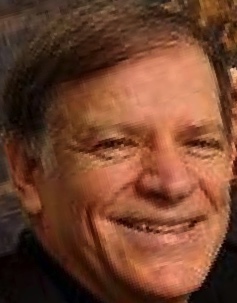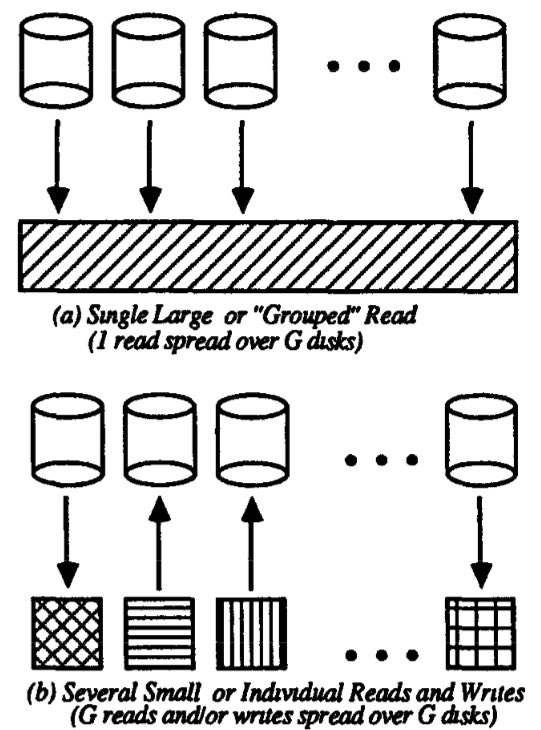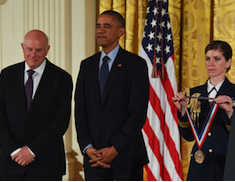Top 6 to 10 Most Prestigious Names in History of Storage Industry
RAID inventors, Moshe Yanai, Dan Warmenhoven, Dr. Eli Harari, Jim Porter
By Jean Jacques Maleval | December 28, 2016 at 2:50 pmHere is a subjective choice of StorageNewsLetter.com‘s editor, journalist on storage without interruption since 1988.
The Top 5 most prestigious names
in the history of the storage industry,
published with details yesterday:
- # 1 Al Shugart
- # 2 Fujio Masuoka
- # 3 Joe Tucci
- # 4 Ramac 350
- # 5 Veritas
Today we publish the next five ones, Top 6 to Top 10:
- # 6 RAID inventors
- # 7 Moshe Yanai
- # 8 Dan Warmenhoven
- # 9 Dr. Eli Harari
- # 10 Jim Porter
#6 Inventors of RAID
The term RAID was invented by David Patterson, Garth A. Gibson and Randy Katz at the University of California, Berkeley, CA in 1987.
In June 1988 they presented a paper A Case for Redundant Arrays of Inexpensive Disks (RAID), at the SIGMOD conference.
It advocated that we should be replacing these big disks by lots of small disks using RAID technology. RAID-5 was the most interesting invention used by about all disk arrays to protect data on HDDs and now on SSDs.
Since then RAID-6 appears with one more parity disk. More recent idea to have multiple copies of data on several nodes in a network could limit the use of RAIDs.
#7 Moshe Yanai, Mr. Symmetrix
and then successful in several storage start-ups

Moshe Yanai was born in 1949 in Israel. He uses to be a tank commander in the Israel Army.
He began at Control Data in 1975 on disk components. He joined EMC in 1987, hired by Dick Egan to design and manage the Symmetrix (now Dell EMC VMAX) development, software and hardware before leaving (or being fired?) EMC in 2001 to form XIV.
According to several sources (not including Yanai himself), he couldn’t get a good salary when he arrives at EMC and offers to get a percentage on each Symmetrix sold. He then was angry to see EMC acquiring Data General at the origin of CLARiiON (then VNX) for as much as $1.1 billion in 1999 because he thought the company was able to design open mid-range arrays. Introduced in 1990, Symmetrix, with large cache memory for fast access to data and HA in a small footprint, was probably the most successful storage products in the history of the storage industry, beating Big Blue with lower-cost 5.25-inch HDDs and cache for mainframes. In 1995, EMC accounted for 41% of mainframe storage terabytes shipped while IBM’s share fell to 35%.
Getting a lot of money at EMC, and then selling Diligent and XIV – where is was a minor shareholder, Yanai is one of the healthiest man in the storage industry. And his fortune could continue to grow with Infinidat, current start-up competing especially but not only with VMAX, finally the best revenge for Yanai.
We met active investor, philanthropist and pilot Yanai twice, the first time several years ago, during a conference he did in Frankfurt, Germany, on XIV – he was a poor speaker -. And we saw him this year in Israel but didn’t have the chance for a face-to-face interview as apparently he does not like the press.
Named IBM Fellow in 2008, he is inventor/co-inventor of about 40 US patents in the field of storage.
In 2010, he was granted the prestigious IEEE Reynold B. Johnson Information Storage Systems Award.
He love to drive his own helicopter notably inviting Madonna and Joe Tucci for a trip.
He is or was involved in the following start-ups as an executive or on the board:
- Arineta (board’s director)
- Axxana, wholly-owned subsidiary of Infinidat (board’s director)
- Diligent Technologies (6% investor), sold to IBM in 2008 for a reported $200 million
- Infinidat (founder in 2011, chairman and CEO)
- Sight Diagnostics (board’s director)
- XIV (investor), sold to IBM for $300 million in 2007 and where he worked until 2010
#8 Dan Warmenhoven, NetApp
Dan Warmenhoven was NetApp CEO from 1994 – leading the company’s IPO in 1995 – to 2009 when he rose to the chairmanship, passing on the CEO slot and then the chairman slot in 2014 to Tom Georgens.
Prior to NetApp, he served in various capacities, including president and CEO of Network Equipment Technologies, a telecommunications company, from 1989 to 1994. He was a veteran of HP, where he served as senior management positions including GM of the information networks group from 1985 to 1989. From 1972 to 1985, he was at IBM in the communications products division, including engineering manager for the token-ring LAN.
When he left as CEO of NetApp, the growing company achieves FY 2019) revenue of $3.4 billion, being leader of the storage industry behind EMC for years.
He is currently, and since 2012, board’s member of Bechtel Group, Palo Alto Networks and Theranos.
We meet him very often, but not only for interviews. We were both heavy smokers and meet together outside to chat at the entrance of shows or conferences. We remember a smart and easy-to-spoke guy.
In 2001, Business Week named Warmenhoven as one of its Top 25 Managers for the year. He has also received the Morgan Stanley Leadership Award for Global Commerce, was named one of the 50 Most Powerful People in Networking by Network World in 2006, and won the National Ernst & Young Entrepreneur of the Year award in 2004.
#9 Dr. Eli Harari, SanDisk
Harari awarded the National Medal of Technology and Innovation
by president Omaha
Dr. Eli Harari co-founded SanDisk in 1988 with the vision of using flash memory to store data in mobile products, due to its small size, ruggedness and low power consumption.
His company shipped the first flash-based SSD in 1991, disturbed the market in 1997 with MLC technology, doubling the density of each memory die to reduce cost. It also introduced the SD card format in 1998 in partnership with Toshiba and Panasonic and developed the smallest NAND flash chip in 2012, which can store 128 billion individual bits of information on an area the size of a U.S. penny.
The history of how flash storage was invented, developed, and made available on a global scale is largely the history of Harari and SanDisk – an American success story that began with one person and a vision. Harari continuously played multifaceted roles over a span of 23 years as inventor, entrepreneur, leader, public company CEO, and industry visionary.
From a Silicon Valley start-up in 1988, SanDisk employed more than 8,000 people worldwide, has over 5,000 patents and $6.5 billion in annual sales in 2015 and finished in the arms of Western Digital for $16 billion in 2015
Harari retired as chairman and CEO on November 2014.
Prior to SanDisk, he held various technical and management positions with Waferscale Integration, Honeywell, Intel and Hughes Microelectronics. He also served as a director of Tower Semiconductor. He began making early contributions to EEPROM, a precursor to flash memory, and he worked on flash memory at Intel, leaving to found a start-up, which failed. In 1988, he launched the company that would become SanDisk with former Intel colleague Sanjay Mehrotra and former Hughes Electronics colleague Jack Yuan.
Along with SanDisk co-founders, Harari received the 2006 Reynold B. Johnson Storage Device Technology Award from the Institute of Electrical and Electronics Engineers. In 2008, the Global Semiconductor Alliance awarded him the Dr Morris Chang Exemplary Leadership Award. In 2009, he received the IEEE Robert N. Noyce Medal recognizing his leadership in the development and commercialization of flash memory technology. In 2011 he was inducted into The Consumer Electronics Association’s Hall of Fame.
He has more than 100 patents issued in the field of non-volatile memories and storage systems.
#10 Jim Porter, Mr. Disk Drive
Resident of Mountain View, CA, James N. Porter, founder and president of analyst firm Disk/Trend, died on March 2, 2012 suffering a massive stroke in Monterey, CA where he attended a Dixieland Jazz Festival.
He loved symphonic music and traditional jazz and also enjoyed camping, hiking and photography.
With Seagate’s CEO Al Shugart, he was considered as the most influential people in the history of the worldwide disk drive industry as he was the voice of this sector from the first day and for 22 years.
Disk/Trend was a consulting and market research company mainly on HDDs. It was founded in 1977 and stopped in 1999 as Porter retired and didn’t find a buyer. Then he became member of the Advisory Board of the Computer History Museum in Mountain View, CA. He told us that he intends to write a book on HDDs but it’s not sure that one page was ever written.
Trendfocus launched by Mark Geenen succeeds to Disk/Trend as the best source of information on HDDs.
I remember to have visited a booth at IDEMA where Porter was showing pictures and an incredible amount of old HDDs and components that he collected.
Some people think that he worked for IBM on the 305A RAMAC, the first HDD (5MB, fifty two-foot diameter disks and the size of a refrigerator). Not true. He never was an employee for IBM, but worked for the company that bought this first unit.
He explained: “After having worked in San Jose for a year in the 1950’s, a really quiet little town and a terrible place for a young man to start his business career, I went 50 miles north and worked in the home office of the company that coincidentally bought the world’s first disk drive. Crown Zellerbach moved into the first new glass curtain wall high rise built in San Francisco after the second World War.“
Prior to starting Disk/Trend, he worked at several companies, including Pabco Paint, Crown Zellerbach, and Cartridge Television, CMX Systems, a CBS-Memorex joint venture. He first became involved with storage products in 1968, when he joined Memorex, serving in a variety of marketing management positions through 1971.
Disk/Trend, in association with Freeman Associates, founded the Diskcon trade show and the DataStorage Conference. He chaired sessions at various trade shows all the way to the end of his life, and participated most recently in the Storage Visions Conference in January 2012.
He was a founder of IDEMA, the International Disk Drive Equipment and Materials Association, serving as chairman and remaining an active member for many years.
We published an exclusive interview from Porter in January 2000 entitled: “We probably will be in the 150GB per platter range ten years from now.” [In 2010 the record was 750GB per disk.] In this interview he refused to tell us his age. “I’m old enough to get social security as they say in United States“, he just said.
Porter graduated from Sequoia High School in Redwood City, CA and San Jose State University.
Born October 3, 1931 in Sacramento CA, he left four children and three grandchildren.
Link to our interview with Porter.


















 Subscribe to our free daily newsletter
Subscribe to our free daily newsletter


